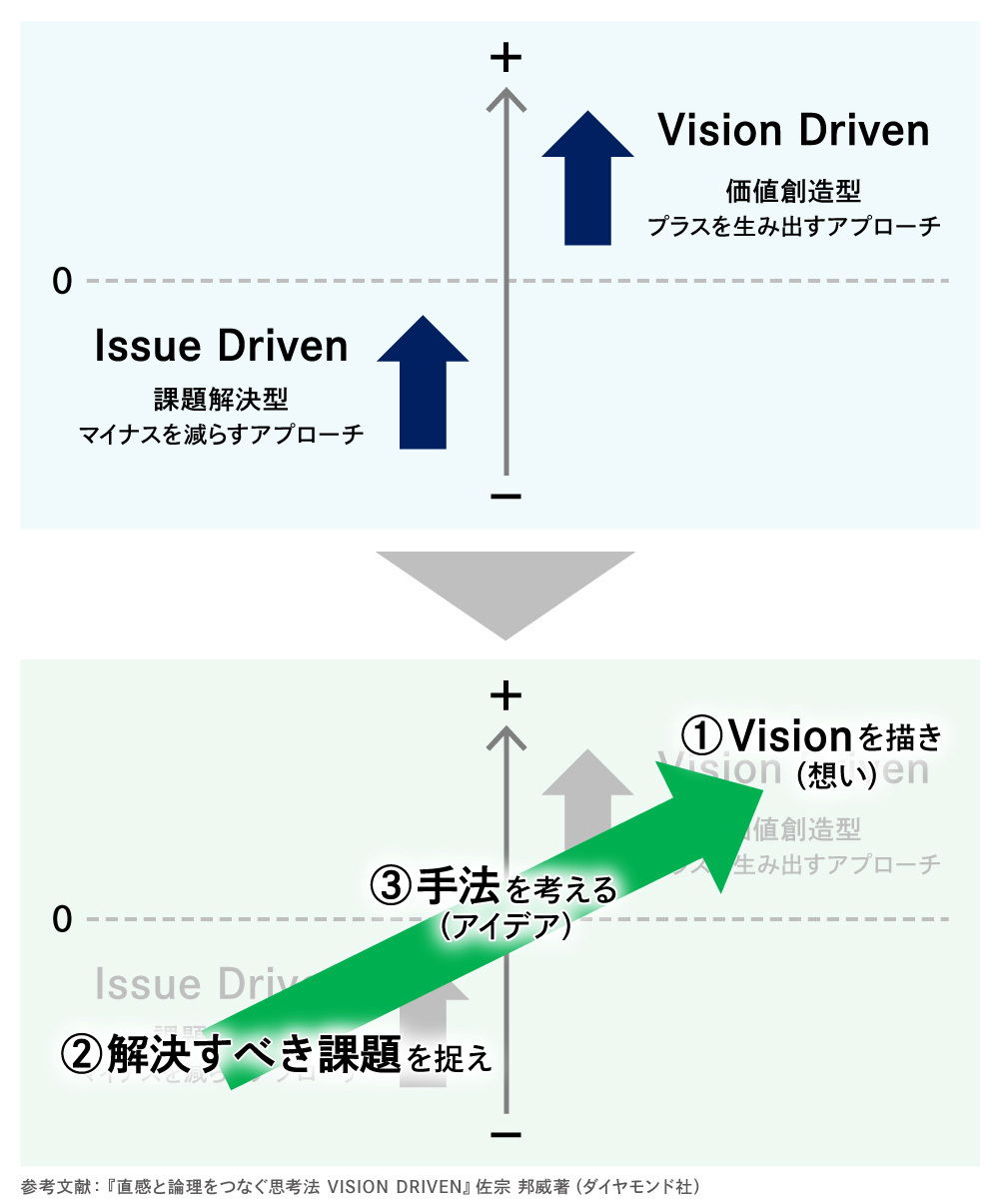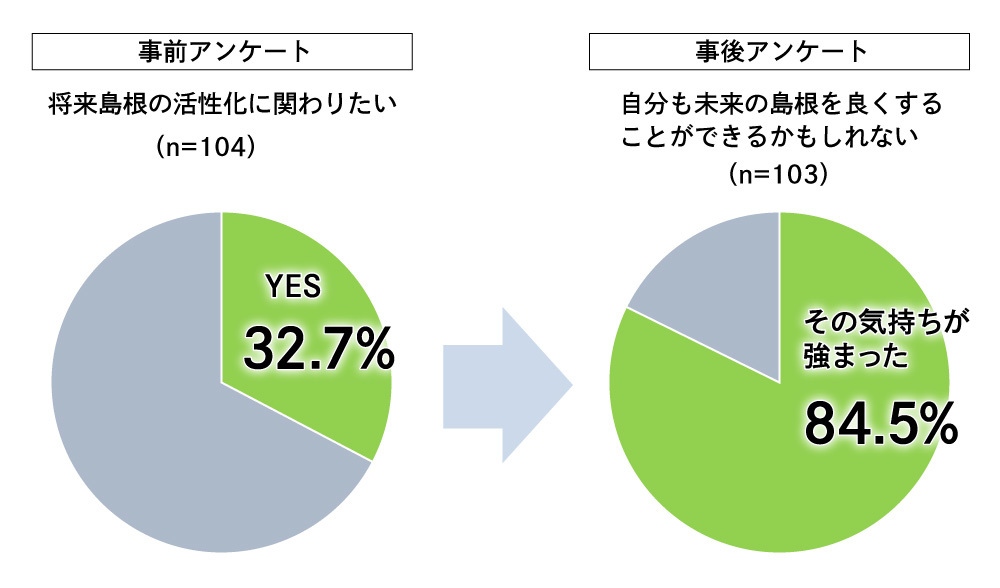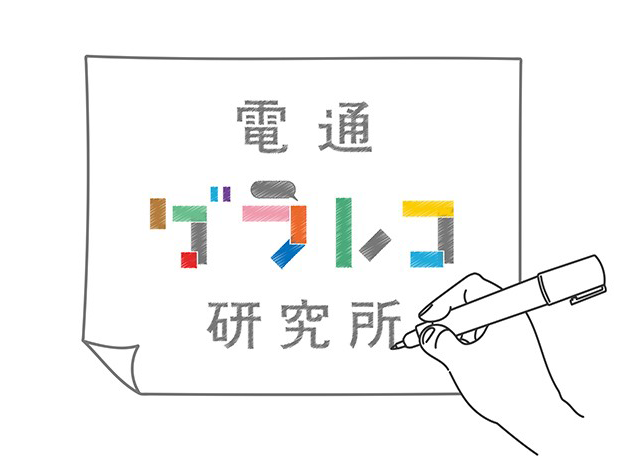The Future Business Creation Lab is a cross-organizational initiative within the Dentsu Group that supports corporate business creation and transformation by visualizing the future.
Rather than starting from solving problems, we begin with a vision of what should be, then concretize what needs to be done to achieve it. Based on this vision-driven approach, the Future Business Creation Lab held the "Sanin Future Classroom 2023" in September 2023, inviting 116 junior high school students in Shimane to envision an exciting future for their region.
The "Sanin Future Classroom 2023" was a project undertaken within the "Future Creation Course" class, which is part of the curriculum for 8th graders (second-year junior high students) at Shimane University Faculty of Education Affiliated School (hereinafter referred to as Shimane University Affiliated School). This initiative was a collaboration with the Sanin Chuo Shimbun, which covers Shimane and Tottori, and Shimane University Affiliated School.
The theme was to develop ideas for a "Future Shimane that is No. 1" – one that makes people want to visit and live in Shimane once they learn about it. The most unique ideas were presented in front of an audience that included not only students but also many adults, such as Mayor Akihito Kamisada of Matsue City, Representative Takeshi Nonomura of Toyota Corolla Shimane, and Representative Masahiro Hiraishi of Monster Lab Omnibus.
【About Future Business Creation Research】
A cross-organizational unit within the Dentsu Group that supports corporate business creation and transformation by visualizing the future. Driven by the desire to create a world where the next generation can once again "look forward to the future," we work daily with client companies to envision the "future that should be" and help them take the first step toward creating it.
https://dentsumirai.com/
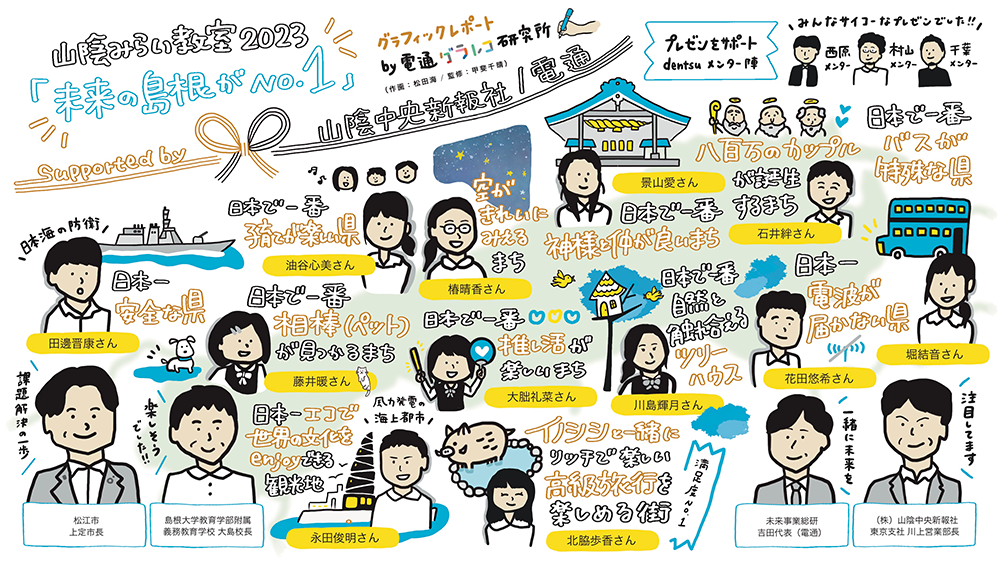
Graphic Report by Dentsu Inc. Graphic Recording Lab: Scene from the Presentation Day ①
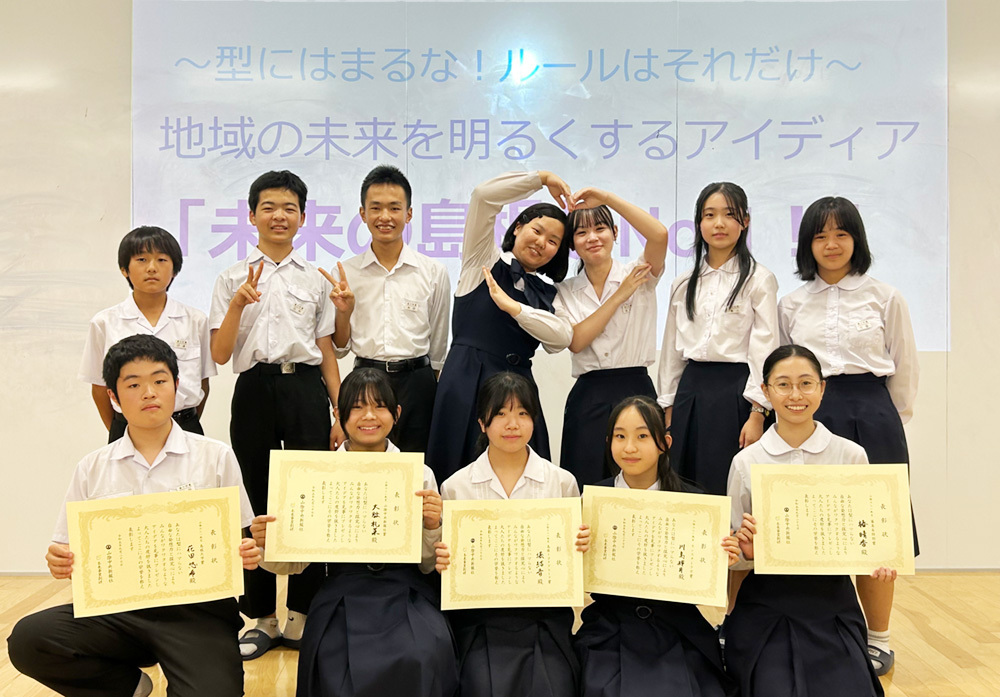
Eighth-grade students from Shima University Affiliated School presenting their ideas.
The future envisioned by junior high students is a "negative future" full of challenges
Population decline is already a nationwide issue in Japan, but in rural areas like Shimane, the decline and aging population are even more severe. Including environmental and energy issues, junior high students' visions of the future are constantly dominated by challenges and anxieties. Focusing primarily on improving these negative points—solving problems and alleviating fears—makes it hard for excitement to emerge.
Vision-driven thinking is an approach that starts by imagining the positive aspects—the fun and happiness—and then links them to challenges. From there, we consider what solutions are needed to make the desired future a reality. However, in this particular initiative, to prevent getting overly fixated on problem-solving and getting stuck in a "future where problems are solved," we limited the linking of challenges to what was feasible. Instead, we focused on affirming the students' feelings and ideas, encouraging them to envision a future where they feel "this is fun" or "this would make us happy."
A Future Shimane That Exceeds Imagination and Sparks Excitement
Ideally, we'd like to introduce all 116 ideas generated by the participants that day, but this article will focus on the 12 presented at the showcase.
First is Haruka Tsubaki's "A Town Where the Sky Looks Beautiful." It won the Judges' Special Award, a brilliant idea balancing Shimane's unique character, lifestyle, and environmental contribution.
It wasn't just about "clear air making the night sky beautiful." It proposed a healthier lifestyle of early to bed, early to rise to reduce nighttime electricity usage, while also leveraging existing strengths and mentioning infrastructure improvements like undergrounding utility poles. It was truly a vision-driven presentation.
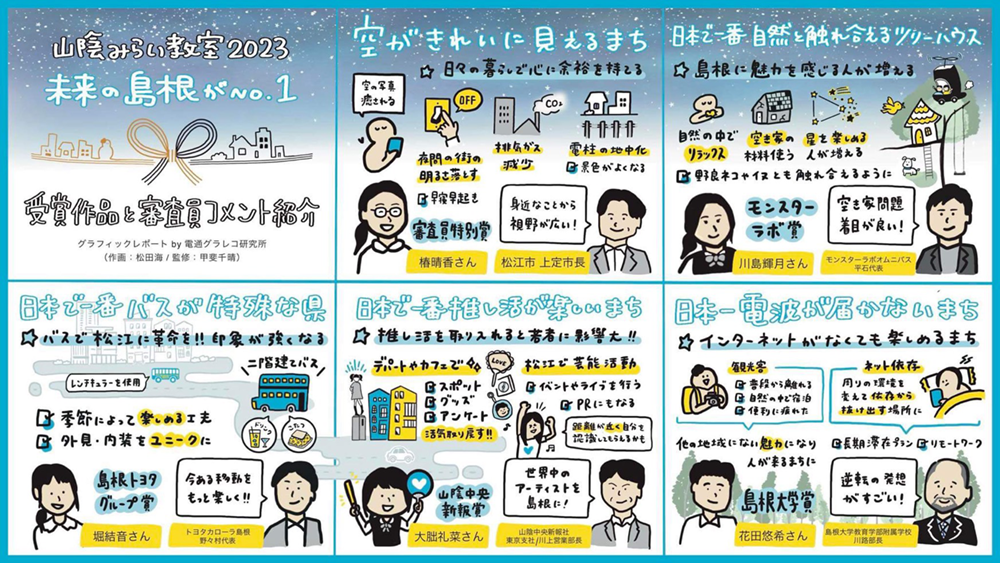
Graphic Report ②: Award-winning students' presentation content and judges' impressions
Kawashima Kizuki's idea was "Japan's Premier Treehouse for Connecting with Nature." Shimane's strength lies in its abundant nature, so the proposal suggested building Japan's top treehouse as a place to fully experience that nature. This also included solutions for the issue of increasing vacant houses due to population decline, such as using scrap materials from abandoned homes to build the treehouse.
"The Prefecture with Japan's Most Unique Buses" is Yune Hori's idea. The key point isn't having many buses or fast buses, but choosing the theme of "unique." In the future, it could become a town gathering unusual and unique buses from around the world. I could also imagine it becoming a sacred place for bus enthusiasts.
Reina Ootsuki envisioned "Japan's Most Fun Town for Fan Activities." By affirming fan culture and positively providing fan-friendly environments throughout the town—like placing merchandise shops and event venues along daily routes—she envisioned a future where artists start their tours and activities from Matsue.
Haruki Hanada's "Japan's Most Radio-Wave-Free Town" turned what was previously seen as a disadvantage into an advantage. By cutting off communication for people dependent on smartphones and the internet, the town would help people reconnect with their natural senses, fully enjoy nature, and gain new insights. Personally, it's a proposal that made me want to visit immediately.
These five proposals were the winners on the day, but the other seven were also excellent, so I'd like to introduce them.

Graphic Report ③: Presentations by the Final Nominees
Shinya Tanabe, who spoke about making Shimane "Japan's safest prefecture," clearly conveyed his genuine interest in and deep research into military and defense matters. His presentation featured many unfamiliar keywords and made us truly realize that safety isn't achieved by doing nothing; it is something people create.
While October is called "Kannazuki" (Month Without Gods) elsewhere, in Shimane it's "Kamiarizuki" (Month With Gods). Legend has it that in October, the eight million gods from across Japan gather at Izumo Taisha for a divine council. Kageyama Ai presented on Shimane Prefecture's unique claim to being "the town in Japan that gets along best with the gods." The theme of being friends with the gods is wonderful, isn't it? It seems like it would bring happiness and make the town feel full of good people.
Connecting with the divine theme, Kizuna Ishii proposed "The Town Where Millions of Couples Are Born." Her ideas included creating 100 wedding venues in Shimane, launching fireworks for every couple, and services that make the marriage registration process fun – all designed to make marriage and couple matching enjoyable.
The idea that drew the most laughter on the day was Ayuka Kitawaki's "A Town Where You Can Enjoy Rich, Fun Luxury Travel with Wild Boars." She proposed creating the world's first wild boar-inhabited lodging where guests could interact with the animals. The lodge would also sell furniture made from boar hide and fur coats. Furthermore, at weddings, a "Ring-Uri Boy" would deliver the rings. This boar-focused idea was unexpectedly fascinating.
Toshiaki Nagata shared his strong desire to make it "Japan's most eco-friendly tourist destination where you can enjoy world cultures." He emphasized that creating places people want to visit is a crucial mission for him, as Shimane lacks recreational spots. However, his idea is on a massive scale: building a floating city on Lake Nakaumi. It was incredibly exciting.
Fujii On proposed the idea of "Japan's Best Town for Finding Your Partner (Pet)". This idea also envisioned a happy future while incorporating content addressing the challenges of rescue dogs and cats, and improving the lives of pets left alone while their owners work. It was a concept full of kindness.
Finally, Kokomi Aburatanii presented "The Most Enjoyable Prefecture for Raising Children in Japan." Her proposal not only promotes mutual support but also includes ideas for creating places to connect ( ) and spots for parents and children to play together. If realized, it truly felt like it would make raising children enjoyable.
Guiding Toward an "Exciting Future"
While these free and unique ideas emerged, a key element emphasized for making this possible is "affirmation from adults." This was also a fundamental rule in the " Future Career School for 14-Year-Olds " previously implemented at Tsukuba Municipal Midori Gakuen Compulsory Education School: adults involved in the project fully affirm the students' ideas.
This communication not only draws out ideas students might otherwise keep hidden—things they fear would be dismissed with "That's impossible" or "Focus on solving problems instead"—but also boosts their motivation to think further.
Eighth graders, straddling childhood and adulthood, possess free-thinking ideas that many adults would immediately dismiss. When adults affirm these ideas, they expand exponentially. This was strongly evident in the "14-Year-Old Future Career School" as well.
The students in Shimane who participated in this project also came to understand Shimane's challenges and the necessity of solving them. Precisely because of this, they were able to shift their thinking: instead of focusing solely on solving problems, they freely imagined what kind of future would be desirable, and then tackled the challenges within the process of working towards realizing that future.
Adults certainly have diverse experiences and recognize risks and implementation difficulties. However, most ideas aren't physically impossible; they're challenging but not absolutely unachievable. Considering the middle schoolers' aspirations and the futures they envision, these ideas are well worth exploring.
"Maybe I can do it too?" shapes future visions
Before this "Sanin Mirai Classroom 2023" program, a survey of the students showed that less than one-third expressed a desire to be involved in revitalizing Shimane in the future. The majority wanted to move to the city or pursue their own interests, which I believe reflects the reality in many rural areas.
Of course, this isn't a bad thing. While contributing to local revitalization is important, it's also wonderful for each person to have their own goals and aspirations and to proactively work towards that future.
However, in the post-project survey, a significant 82.3% of students reported feeling more strongly that "I might be able to help make Shimane's future better."
While there wasn't a significant change in the number of students wanting to live or work in Shimane before and after the project, this heightened sense of possibility was very encouraging. I believe it reflects their realization that there are many ways to improve their local Shimane without necessarily needing to work or live there permanently.
Furthermore, I believe that coming up with concrete ideas and having them affirmed boosted their confidence. Moving from a state of uncertainty about how they could contribute or what would improve Shimane, to seeing over 100 ideas laid out before them, allowed them to concretely imagine what might be possible. The feeling of "I can relate to this," "I might be able to do this," or "I want to do this" was also significant.
To help the next generation build a better future
What we adults should do going forward is nurture the aspirations and ideas of young people and students, who will be at the center of the future. To achieve this, I believe it's crucial first to affirm their aspirations and ideas. Rather than judging their feasibility, we should focus on thinking together about how to make them even better.
When we hear young people's or students' ambitious ideas, we often instinctively urge them to scale back to "something achievable" for their own sake. However, introducing a perspective focused on "making it even better" can lead to situations where "a way to make it work becomes visible, even if it seemed impossible before," or where "an idea even better than the original one emerges."
We believe this experience of thinking will inspire each person to value their vision and consider what they should do to create the future they envision. We sincerely hope many young people across regions will experience this, and we are actively promoting its expansion and sharing. If you are interested, please feel free to contact us. Let's work together to increase the number of young people creating a better future.
Contact: Future Business Creation Research Institute (Contacts: Yoshida, Yamada)
future@dentsu.co.jp
【Graphic Recording & Report Production Collaboration】
Dentsu Inc. Graphic Recording Lab (Artwork: Kai Matsuda / Production Supervision: Chiharu Kai)
Dentsu Graphic Recording Lab is a cross-group project team within the Dentsu Group dedicated to providing and researching visualization services centered around graphic recording.
https://www.dentsu.co.jp/labo/grareco/index.html






